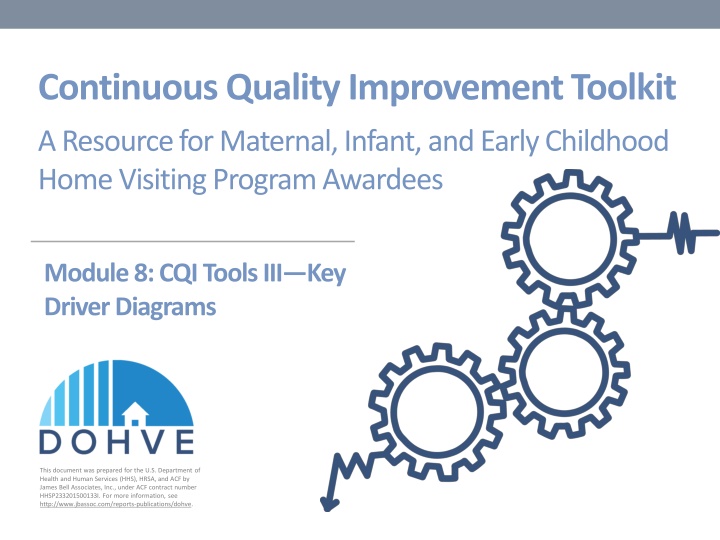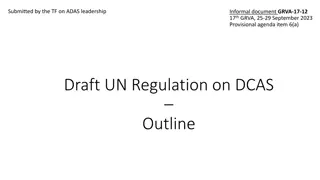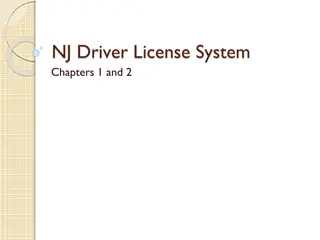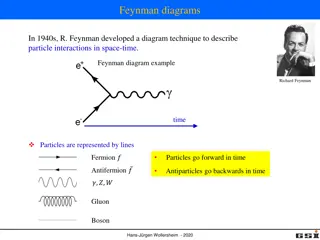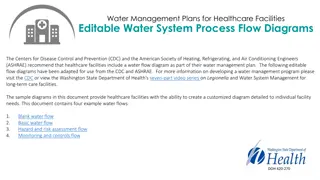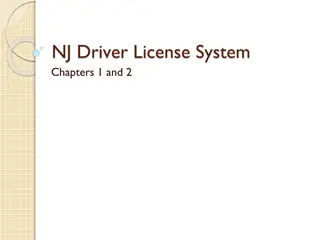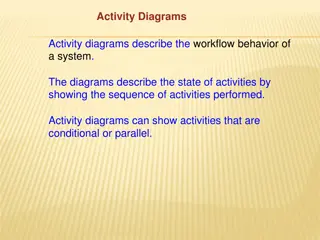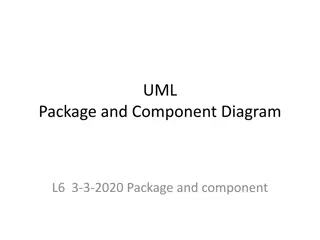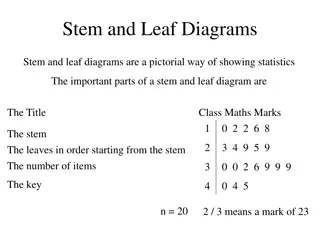Key Driver Diagrams in Continuous Quality Improvement
Key Driver Diagrams are essential tools in Continuous Quality Improvement (CQI) processes. They help visualize the primary drivers, change strategies, and SMART aims to achieve improvement goals. Understanding, creating, and utilizing Key Driver Diagrams play a significant role in promoting quality enhancements within maternal, infant, and early childhood home visiting programs.
Download Presentation

Please find below an Image/Link to download the presentation.
The content on the website is provided AS IS for your information and personal use only. It may not be sold, licensed, or shared on other websites without obtaining consent from the author.If you encounter any issues during the download, it is possible that the publisher has removed the file from their server.
You are allowed to download the files provided on this website for personal or commercial use, subject to the condition that they are used lawfully. All files are the property of their respective owners.
The content on the website is provided AS IS for your information and personal use only. It may not be sold, licensed, or shared on other websites without obtaining consent from the author.
E N D
Presentation Transcript
Continuous Quality Improvement Toolkit A Resource for Maternal, Infant, and Early Childhood Home Visiting Program Awardees Module 8: CQI Tools III Key Driver Diagrams This document was prepared for the U.S. Department of Health and Human Services (HHS), HRSA, and ACF by James Bell Associates, Inc., under ACF contract number HHSP233201500133I. For more information, see http://www.jbassoc.com/reports-publications/dohve.
CQI Training Overview 1 2 3 4 5 6 7 8 9 Introduction to CQI Using Data to Drive CQI and Identify Topics Creating the CQI Culture and Forming a Team Creating SMART Aims Understanding the PDSA Process & Measurement CQI Tools I: Process Maps CQI Tools II: Root Cause Analysis Tools CQI Tools III: Key Driver Diagrams Reliability Concepts and Sustaining Gains
Key Driver Diagrams: Learning Objectives Describe Key Driver Diagrams Explain how Key Driver Diagrams are used in CQI Create Key Driver Diagrams Use Key Driver Diagrams in CQI
WHAT IS A KEY DRIVER DIAGRAM?
CHANGE STRATEGY PRIMARY DRIVER SMART AIM
CHANGE STRATEGY PRIMARY DRIVER SMART AIM
CHANGE STRATEGY PRIMARY DRIVER SMART AIM
CHANGE STRATEGY PRIMARY DRIVER SMART AIM
CHANGE STRATEGY PRIMARY DRIVER SMARTAIM 1. Support to develop interpersonal relationships and adult attachment Observation of home visits by supervisor Primary Driver 1: Competent and skilled workforce to support enrollment and retention 2. External Sources 1. Outreach to home visiting clients to refer a friend to home visiting 2. Policy and protocol with guidelines for assessing and determining eligibility 85% of families receive expected home visits by 6 months into the fiscal year Primary Driver 2: Prompt and appropriate enrollment of eligible families Internal Sources 1. Standardized and welcoming intake process 2. Completed family checklist on family s wants and needs for home visiting Adapted from HV CoIIN Family Engagement KDD
WHY USE A KEY DRIVER DIAGRAM
Benefits of Key Driver Diagrams Define system to be improved Provide a common model for CQI team Help narrow possible change strategies
Benefits of Key Driver Diagrams Link specific measurement criteria to change strategies Focus the team to test one change strategy at a time Help track successes and challenges
CREATING A KEY DRIVER DIAGRAM
Steps to Create Key Driver Diagrams
Key Driver Diagram Best Practices Change Strategies PrimaryDrivers Neutral language Linked to aim Evidence-based Linked to at least one driver Developedwith help from subject matter experts
CHANGE STRATEGY PRIMARY DRIVER SMARTAIM 1. Support to develop interpersonal relationships and adult attachment Observation of home visits by supervisor Primary Driver 1: Competent and skilled workforce to support enrollment and retention 2. External Sources 1. Outreach to home visiting clients to refer a friend to home visiting 2. Policy and protocol with guidelines for assessing and determining eligibility 85% of families receive expected home visits by 6 months into the fiscal year Primary Driver 2: Prompt and appropriate enrollment of eligible families Internal Sources 1. Standardized and welcoming intake process 2. Completed family checklist on family s wants and needs for home visiting Adapted from HV CoIIN Family Engagement KDD
PRIMARY DRIVER SMARTAIM CHANGE STRATEGY Primary Driver 1: Competent and skilled workforce to support enrollment and retention 1. Support to develop interpersonal relationships and adult attachment 2. Observation of home visits by supervisor External Sources 1. Outreach to home visiting clients to refer a friend to home visiting 2. Policy and protocol with guidelines for assessing and determining eligibility Primary Driver 2: Prompt and appropriate enrollment of eligible families 85% of families receive expected home visits by 6 months into the fiscal year Internal Sources 1. Standardized and welcoming intake process 2. Completed family checklist on family s wants and needs for home visiting Primary Driver 3: Comprehensive data-tracking system 1. Initial and ongoing training for HVs on policies and procedures for data tracking and management 1. Process for family to meet other team members to increase connection with program staff 2. Parents included as members of policy council 3. Parent-led support groups Primary Driver 4: Active involvement of families in home visiting program Adapted from HV CoIIN Family Engagement KDD
USING A KEY DRIVER DIAGRAM IN CQI
Do Act Plan Study
Key Driver Diagram Activity Step 1: Develop the SMART aim Step 2: Identify key drivers Step 3: Identify change strategies
Key Driver Diagram Activity Debrief Which subject matter experts could teams include in the development of the Key Driver Diagram? What resources could teams use to research evidence based change strategies? What was the most challenging part of developing the Key Driver Diagram? Which change strategy will the team test? Provide a rationale for how the change strategy will influence the outcome.
Remember... Key Driver Diagrams connect change strategies to drivers to aims. Use best practices when developing Key Driver Diagrams. Key Driver Diagrams are used throughout the PDSA process. 1. 2. 3.
Additional CQI Resources CQI Briefs: http://www.jbassoc.com/reports-publications/dohve Quality Improvement Toolbox: http://www.hrsa.gov/quality/toolbox/methodology/qualityimpr ovement/index.html
Disclaimer The purpose of the Design Options for Home Visiting Evaluation (DOHVE) is to provide research and evaluation support for the Maternal, Infant, and Early Childhood Home Visiting (MIECHV) Program. The project is funded by the Administration for Children and Families (ACF) in collaboration with the Health Resources and Services Administration (HRSA) under contract number HHSP233201500133I. This publication was developed by James Bell Associates on behalf of the U.S. Department of Health and Human Services (HHS), HRSA, and ACF. Its contents are the sole responsibility of the authors and do not necessarily represent the official views of HHS, HRSA, or ACF.
